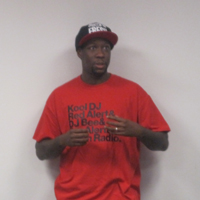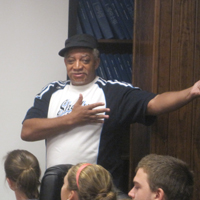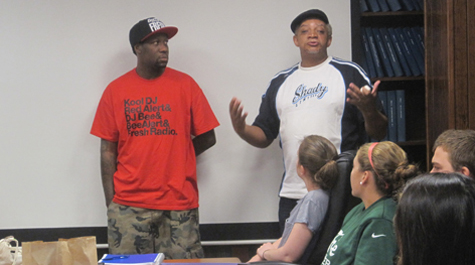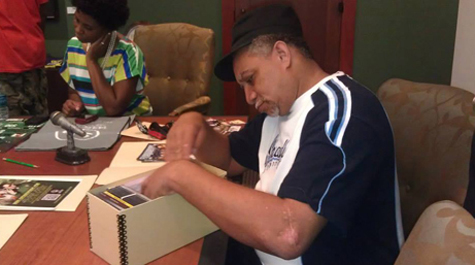Hip-hop pioneer shares history of genre with W&M students
You want to know the history of hip-hop, as seen through the eyes of one of the genre’s legends, Kool DJ Red Alert?
Go back to the early 1970s, he told a group of American studies students at William & Mary recently, and start with a Jamaican immigrant known as DJ Kool Herc. He took popular songs, found obscure parts that he considered funky, mixed them together and, in 1973, began playing parties.
{{youtube:medium|zAPy3IZ2R8g, Red Alert and DJ Bee discuss their art.}}
Kool Herc became friends with an MC –the early term for a rapper -- Coke La Rock. Together, they bought equipment and started producing shows open to all ages and genders in the Bronx and Harlem.
“I’d see gang fellows, who used to fight each other, now hanging out at the same place,” said Red Alert, who grew up in Harlem and attended an all-boys school where there were at least a dozen warring gangs. “Some were still selling drugs, but they were being social with each other.”
 Party goers wanted to show off their dance moves, the more acrobatic the better. Break dancing was born.
Party goers wanted to show off their dance moves, the more acrobatic the better. Break dancing was born.
“At the beginning of hip-hop, there was no hip-hop music,” explained DJ Bee, a radio personality and tunrtablist who accompanied Red Alert to campus. “It was basically disco, with dancing to the funk part of the record, just beat, no words . . . We didn’t have samplers to loop over a part of a song over and over. We had to use the turntables. The turntablist kept the best part of the song going over and over, the Beat Boys started dancing to it, the writers used that for inspiration to write something . . . I just got into it.”
Eventually, other DJs began attending Kool Herc’s shows and were inspired by what they saw and heard.
“One thing you learn about genres of music is that a lot of them come from a culture,” Red Alert said. “Jazz comes from a culture. Rock ’n Roll comes from a culture. Country western comes from a culture. You may just think of the music, but it’s also about the lifestyle around it, what was going on, how were they addressing each other, how were they presenting themselves, what were they wearing? The music became all of that because it was a presentation of what they stand for.
“Same for hip-hop. We represent where we come from. We learned to make something out of nothing, not knowing what it could become later on. In any form of the culture, they strip down to the first thing, and that’s always the music.”
Red Alert said a small, space-saving invention – the cassette tape – helped propel hip-hop across the nation.
“Whoever recorded a party that night between a DJ and an MC, that tape traveled and traveled,” he said. “As these tapes traveled around, it caught the attention of record companies. ‘What is this thing doing? What is this sound? Why are they doing this?’
“Soon you had individuals coming to these parties finding out what was going on and seeing how it commanded the audience, how big a following it was, how it was getting across to everybody in the inner city.”
 Record executives brought some of the artists into their studios, a development once thought impossible.
Record executives brought some of the artists into their studios, a development once thought impossible.
“Now the records were being played in different places and, little by little, started getting to the radio,” Red Alert said. “Super Rockin' Mr. Magic – may he rest in peace – gets credit for bringing it to the airwaves on New York’s WHBI. You had to buy airtime. He got some sponsors and bought airtime. He would be on 2 o’clock Saturday night/Sunday morning – but we all listened to him. A major radio station picked him up.”
Red Alert did more than his share. He fostered a collection of hip-hop artists who became known as The Native Tongues. Among them were Queen Latifah, Monie Love, The Jungle Brothers, De La Soul, A Tribe Called Quest, Black Sheep and Chi-Ali. Their lyrics addressed a wide range of topics, from spirituality and modern living to race, sex and just having fun. It appealed to the mainstream.
Hip-hop kept welcoming every style of music to join it, including New Wave/Punk Rock, as in Madonna, The Talking Heads, Devo.
“The word spread,” he said. “They're underground; we're underground, and we’re trying to see if we can bring this to the next level. As time went by, the sound spread to other places – Philly, Boston. It became massive.”
This year, hip-hop is celebrating its 40th anniversary. Following their presentations, DJ Red Alert and DJ Bee visited W&M’s hip-hop collection, housed at Swem Library. Kevin Kosanovich, an American studies doctoral candidate who has been the driving force behind the collection, accompanied them on a nostalgic look back on four decades no one ever imagined.
 Skip to main content
Skip to main content


